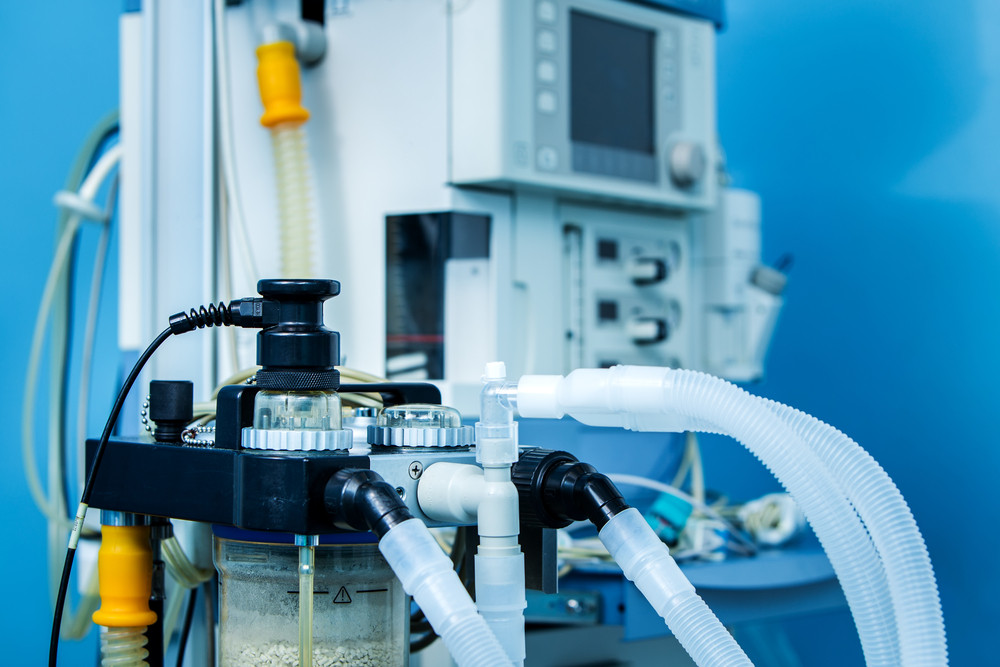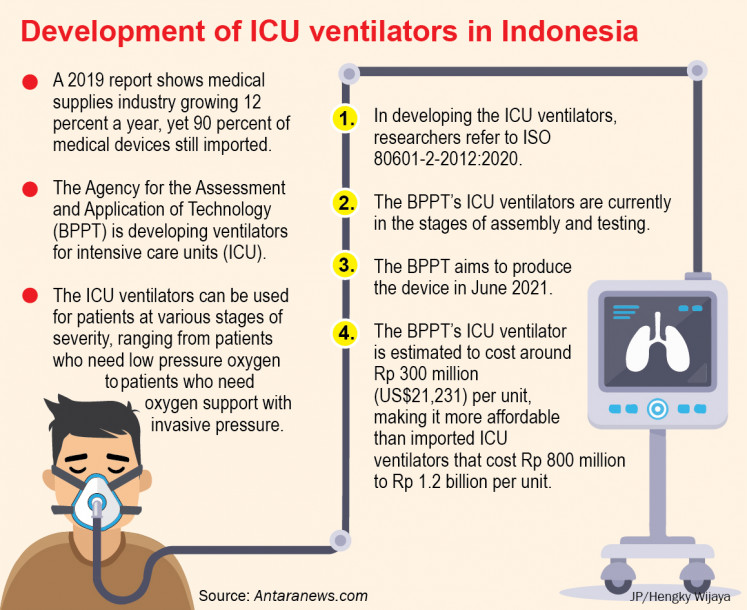Popular Reads
Top Results
Can't find what you're looking for?
View all search resultsPopular Reads
Top Results
Can't find what you're looking for?
View all search resultsBPPT develops ICU ventilators, reducing need for equipment imports
The COVID-19 pandemic is a wake-up call for Indonesia’s healthcare industry, and the local production of ventilators is a step in the right direction.
Change text size
Gift Premium Articles
to Anyone
 Illustration of ICU ventilator. The national COVID-19 task force’s research and innovation consortium has made ventilators a priority, leading various organizations, such as the Agency for the Assessment and Application of Technology (BPPT) to develop ventilators for intensive care units (ICU). (Shutterstock/egyjanek)
Illustration of ICU ventilator. The national COVID-19 task force’s research and innovation consortium has made ventilators a priority, leading various organizations, such as the Agency for the Assessment and Application of Technology (BPPT) to develop ventilators for intensive care units (ICU). (Shutterstock/egyjanek)
The COVID-19 pandemic is a wake-up call for Indonesia’s healthcare industry.
According to a Health Ministry report published in 2019, the country’s medical supplies industry increased by 12 percent a year, but 90 percent of medical devices were still imported.
Given the current health crisis, Indonesia can no longer rely on medical device imports, especially for important equipment, such as ventilators.
With that in mind, the national COVID-19 task force’s research and innovation consortium has made ventilators a priority, leading various organizations, such as the Agency for the Assessment and Application of Technology (BPPT) to develop ventilators for intensive care units (ICU).
According to clinicalgate.com, ICU ventilators were adapted from standard anesthetic equipment by the addition of a separate circuit that allowed the patient to take a spontaneous minute volume over and above that delivered by the device.
BPPT deputy head of information technology, energy and material Eniya Listiani Dewi explained on Saturday that the device was different from emergency ventilators, as it came with more complex technology and functions to help a patient in critical condition breathe by assisting the lungs to inhale and exhale air.
“ICU ventilators are equipped with a ventilation mode with a control function for air volume and pressure,” she said, as quoted by kompas.id on Monday.
Speaking about the BPPT’s ICU ventilators, Eniya explained that the device was equipped with a feedback system to read the patient’s respiratory rate and pattern.
Moreover, the ventilators can be used for patients at various stages of severity, ranging from patients who need low pressure oxygen to patients who need oxygen support with invasive pressure.
The researchers referred to ISO 80601-2-2012:2020 in developing the ICU ventilators.
Eniya said the BPPT’s ICU ventilators were currently in the stages of assembly and testing.
The agency has set a target to submit the device to the Health Ministry’s health facility security center (BFFK) for certification at the end of this month and hopes to produce the device in June 2021.
Read also: ICU ventilators: What they are, how they work and why it’s hard to make more
The BPPT has also teamed up with PT Dharma Precision Tools to mass produce the device to accommodate demand from all hospitals in Indonesia, especially type C (with limited subspecialist medical services) and D (with basic specialist medical services) hospitals.
With regard to the price, the ICU ventilators produced by BPPT are estimated to cost around Rp 300 million (US$21,231) per unit, making them more affordable than imported ICU ventilators, which cost between Rp 800 million and 1.2 billion per unit.
BPPT head Hammam Riza explained that the device was a type of development from three emergency ventilators produced by the BPPT.
He said that ventilators were currently a crucial medical device, as more COVID-19 patients needed breathing assistance.
“[The device] will also be needed after the pandemic ends [and] can be a substitute for imported ventilators,” he added. (jes)
Editor’s note: This article is part of a public campaign by the COVID-19 task force to raise people’s awareness about the pandemic.











